Indian Spices – A guide to Essential Spices
Updated: September 2, 2023, By Swasthi
Spices are an essential part of Indian cooking. There is hardly any Indian dish, sweet or savory that does not use spices in some form or the other. In fact, many dishes use a combination of whole and powdered spices. This post shares complete details along with the pictures of various spices and their uses in Indian cooking.
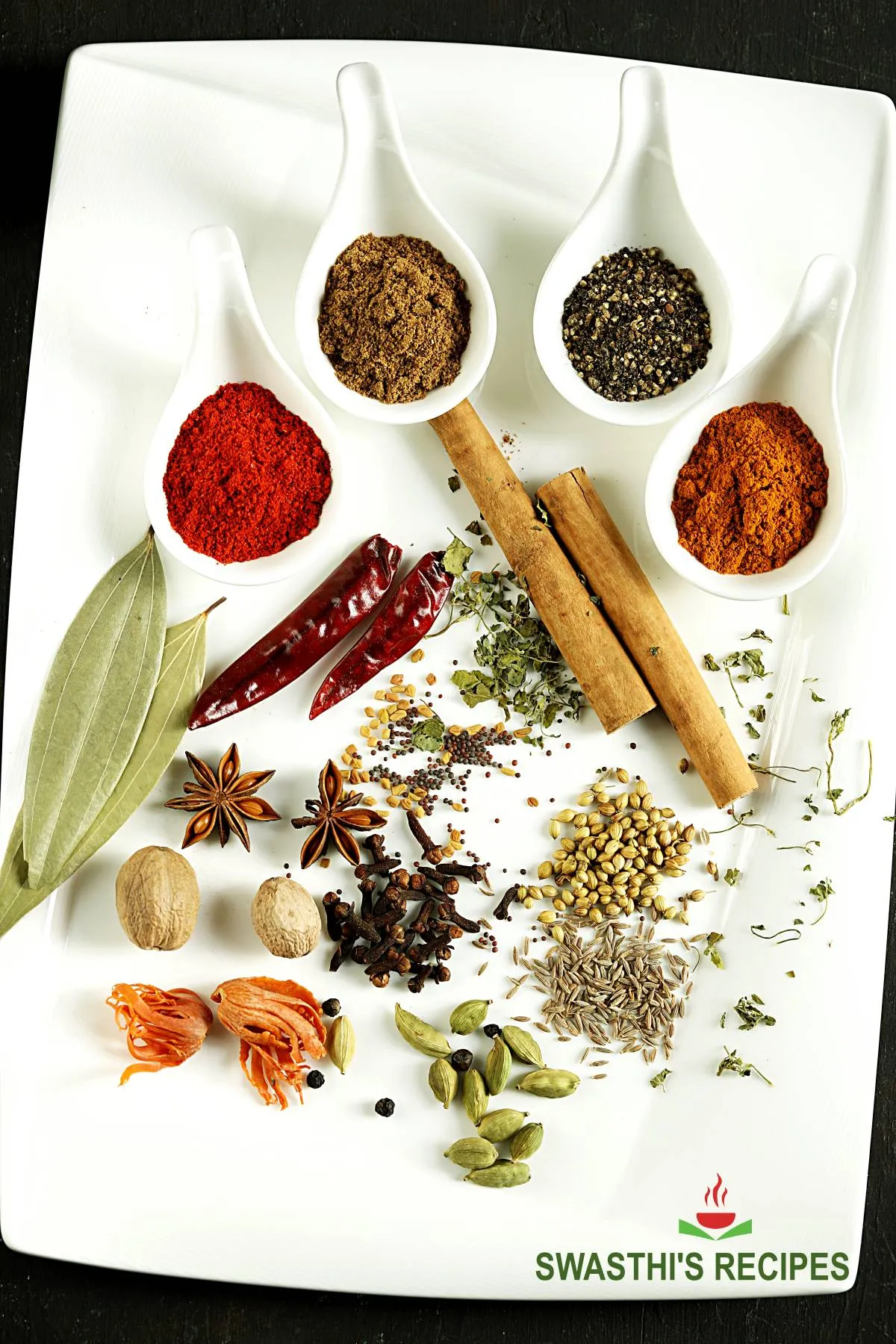
India is the home of spices, most locally grown, that are used in Indian cooking to add color, flavor, taste and aroma to the food. The tantalizing taste of spices, often used in various combinations, make Indian food what it is. Apart from appealing to the senses, these spices often yield multiple health benefits.
To give you some examples, turmeric and garlic have been prized for their antibiotic and healing properties, carom and fennel seeds for their digestive effects, last but not the least cardamom, cinnamon, cloves, and ginger for their soothing and respiratory benefits.
Basic Spices in an Indian Kitchen
In this post I share with you the details of Indian spices, how they are used and the purpose. This will help you buy and customize your meal with the most essential spices suitable to your palate and body type.
Most Indian kitchens will have a spice box known as “Masala Dabba” for easy access to spices while cooking. I will share more details on how to choose and organize a Masala Dabba soon. Apart from salt, these are some of the spices that you will find in an Indian kitchen:
Red Chili Powder
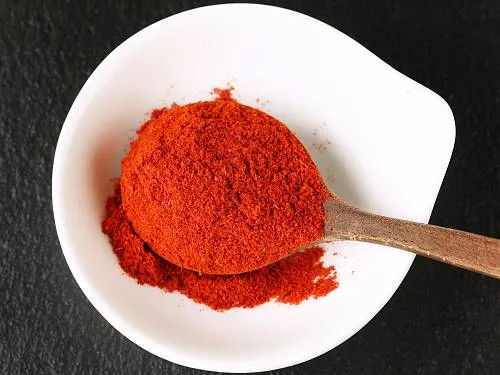
Indian red chili powder is pure 100% ground dried red chilies. This is the main basic spice you should know if you are new to Indian food. There are a zillion kinds of Indian chili powder available in the market and it is hard to decide on one.
Every family has their own preferred choice, depending on the region and their heat tolerance levels. So to begin with, you will look for something that’s going to match your taste buds & preferences – mildly hot, hot and super hot.
If you don’t or can’t eat hot spicy foods start with chili powder that is very mild like Kashmiri chili powder or the Byadgi dabbi (different from Byadgi kaddi which is slightly hotter). This is what I have always used & have interchanged one for the other with the same quantities.
If you want higher levels of heat in your dishes try with Guntur chili powder and lavangi. Some people also use a mix of mild and hot chilies to balance the heat levels.
A key point to note here is that too much of hot chili in your diet can cause skin and digestive problems. So try with smaller amounts.
Mustard Seeds (Rai)
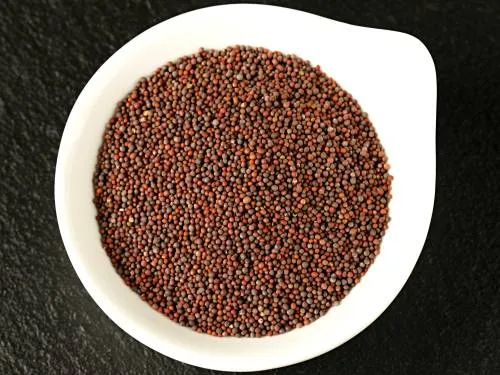
This rounded black seeds actually come in different sizes ranging from small to large. Most often, it is medium one that is used. Black mustard seeds are used in their whole form in tempering of lentils, in vegetables, rice and other dishes. Dal Fry, Poha and
Eggplant Curry are some examples.
Whole seeds are also used in pickles, chutneys and namkeens or fried mixtures where a tempering is required.
They are spicy, mild and often yield a nutty and pungent aroma when fried. The seeds have to splutter in the oil, else they taste bitter. When ground, it is often used in pickles/ achaar, achari tikkas and achari curries like Achari Chicken, Achari Paneer, to add a pungent flavor. It is also used to sour some liquids like Kanji made in North India and Rajasthan.
Mustard seeds are otherwise more widely used in South India, where they are usually paired with cumin seeds and curry leaves. Some examples are this Upma and this Kadala Curry.
Cumin Seeds (Jeera)
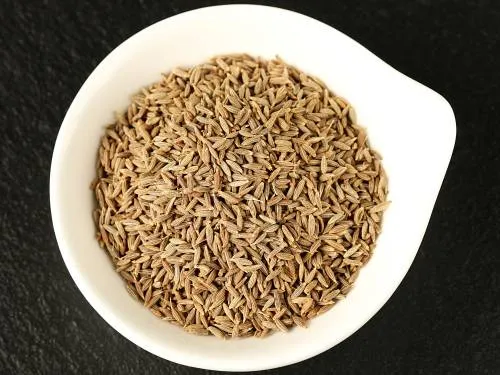
These are elongated pods that are dried. They are also used in vegetables, lentils, rice dishes. Typically, cumin seeds are fried as a part of tempering. They may or may not be used along with black mustard seeds.
Cumin, when roasted and powdered is warm and nutty and is often part of blended spice mixes, including garam masala, sambar powder, curry powder and rasam powder.
Cumin seed powder goes well with coriander powder. It is used along with red chilli powder, turmeric powder and salt as the basic spices for a number of Indian dishes like curries and stir fry dishes.
When freshly roasted and ground, it is also used as a garnish or finishing spice for Raita, spiced buttermilk/ Chaas. It can also be used on top of cooked lentils, vegetables, salads, chaats, snack foods, Grilled Sandwiches and more.
Fenugreek Seeds (Methi Dana)
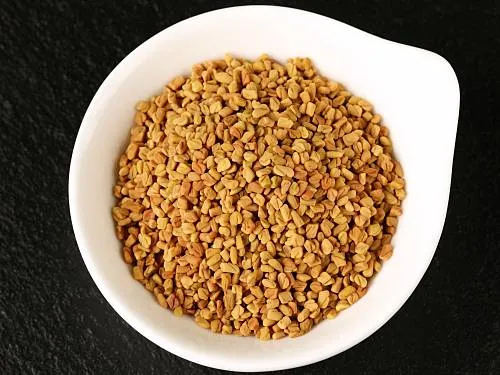
Fenugreek seeds are often used whole in tempering. They can be quite bitter with an undertone of maple flavor, so they are used in minute quantities. Fenugreek seeds are also part of pickled dishes (achari masala) and panch phoran (the whole Bengal spice mix).
They are protein rich and can be sprouted and used in salads for crunch. Often used in lentils and pickles, fenugreek seeds are well-known for their benefits in diabetes treatment.
When powdered, they are used in many blended masalas, in a small quantity because of their bitterness, like sambhar masala, rasam powder & others.
The powder is also used to make Methi Laddoos that are beneficial post-delivery and lactation. They are also helpful to ward off winter chills when ginger, jaggery and other hot spices are added to the laddoos.
Fenugreek is also used in certain recipes to aid fermentation. Like in Lemon Pickle, Mango Pickle, Idli and Dosa batter preparations.
Turmeric (Haldi)
Turmeric is known for its antibiotic and anti-microbial properties and also its golden yellow color that tends to leave stains. It is a rhizome that looks a lot like ginger, except that it is yellow-orange in color.
Turmeric is largely used as a powdered spice to impart a golden color and earthy flavor to the dishes. It is used in small quantities. Examples are this Lemon rice and Turmeric rice.
Turmeric powder is used in hot oil or hot food to remove the raw taste. Hot oil also enhances its anti-oxidative properties. And if you add some pepper to any dish containing turmeric, you get greater benefits from both spices. Examples are this Turmeric tea and turmeric latte.
However, the fresh rhizome is also used in curries, Turmeric Shots, Turmeric milk, vegetables and in pickles.
Dried Red Chilies (Sukhi Lal Mirch)
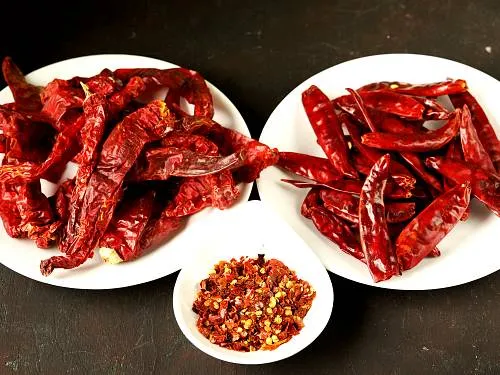
Dried Red chilli is commonly used in whole and ground form, lending color and heat to the dish. There are innumerable varieties of red chilies available. They may be sweet and lend a lot of color, but no heat (like Kashmiri chilies) to the more orangish ones that can be quite pungent, fiery and hot, but do not add that much color.
Red chillies can be used finely powdered, coarsely powdered, flaked or whole. Dried whole chillies are often broken (sometimes left whole) and added to lentils and other dishes as a part of tempering like in this Dal Tadka.
In many dishes, some red chilli powder may be used and some whole dry and fresh chilies are also used for added taste and flavor. The fresh spice has a different sharpness. Often, commercial red chili powder is a blend sourced from different kinds of red chillies unless specified.
Our favorite red chili varieties are the Mathania, Kashmiri and Bydagi. All these are low in heat. It is essential to choose the original kind if you prefer low heat and better flavor. A point to note is that these varieties are a lot of times adulterated with cheaper kind of chilies. So buy from a well-known brand.
Coriander Seeds
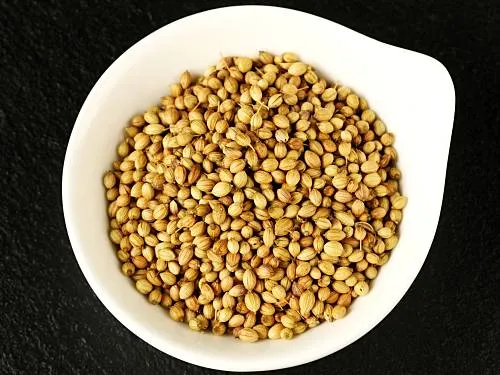
Coriander seeds have a lemony & tangy flavor and some woody notes. They can be used whole in many dishes, roasted and powdered. Coriander is used in lentils, vegetables and meat dishes, coarsely crushed and used as a topping for kulchas, in stuffing such as those for kachoris, and in some parathas and cutlets.
This spice is also a part of blended mix masalas like garam masala and almost all other spice blends, including curry powder. Coriander powder is used quite liberally as it adds body and complexity to the foods.
Coriander seeds are often used in spice rubs and, when crushed, used in soups, stews, curries and stir fries. They are typically used along with cumin seeds or powder and along with other Indian spices.
Fragrant Indian spices
Cinnamon
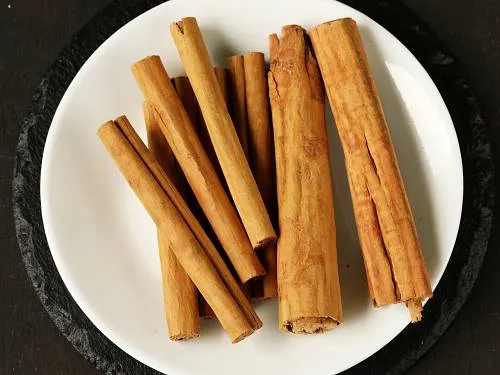
Cinnamon is of two kinds: pure Ceylon cinnamon and cassia cinnamon. While the two have similar tastes and flavors, they can be used interchangeably but not in the same quantities. Cassia is more stronger in flavor. They have some different health benefits.
Pure Ceylon cinnamon bark consists of layers that you can see, and are easier to break. Cassia cinnamon may be thicker and does not have visible layers. Cassia cinnamon is much cheaper than pure Ceylon cinnamon.
It is advisable not to have a lot of cassia cinnamon if you suffer from liver problems. The broken cinnamon may be used in rice dishes, in sweets and in lentils and chickpea curries like Chana masala and Punjabi Chole.
Cinnamon is a vital part of garam masala. It is often used to flavor Masala Chai along with ginger, cardamom, cloves, black pepper and other spices. It is often used to treat respiratory infections.
It’s mild, sweet fragrance and aroma lends itself well to Indian foods like makhanwala, whole bean dishes, various gravies and the powdered spice is used in Fruit cakes and pies.
Cloves
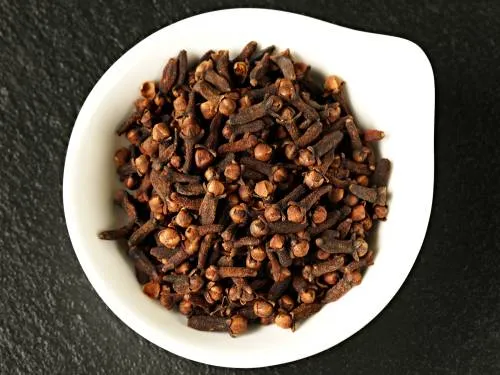
Whole cloves have a pungent and spicy aroma. They are used in rice dishes such as Pulao and Biryani, in meat dishes, in gravies and sweet dishes including cakes and cookies. You need to use just a few cloves, as they have a strong flavor.
Clove powder is rarely used on its own, but is powdered along with other spices into garam masala and many spice blends. Cloves are known for their oral health benefits, for tooth pain and for fresh breath. So the whole cloves are also used to put/bind a paan together.
If you find yourself to be having a lot of cloves, you can place them in your cabinets, rice and flour bags to prevent worms. At home we also use them in our wardrobe.
Green Cardamoms
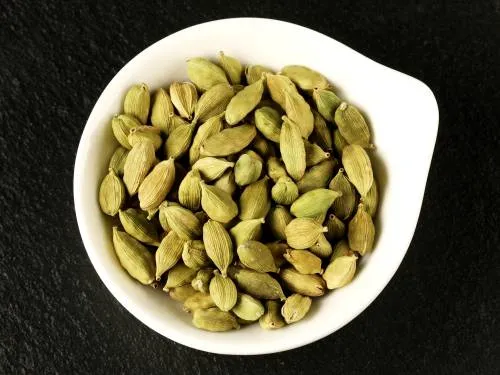
The small green pods with seeds of green cardamoms are flavorsome with a somewhat minty flavor with tones of eucalyptus. They may be ground, split or left whole and put in Sweet dishes, halwas, Indian sweetmeats and tea.
Green cardamoms may be used in makhani dishes, in pulao, biryani and in many gravies, marinades and rubs. They are an essential part of milk masala that is used to flavor milk along with saffron, nuts and other spices. Cardamom is also a part of Thandai and Badam milk.
Unused pods, from which the seeds are removed, can be added to your tea leaves stored in a jar or canister to gently flavor the tea.
While cardamom powder is easy to use, it is best to lightly crush the seeds of the cardamom pods just before using to extract the most flavor and taste. Unless you use cardamom powder regularly, just keep in mind that the powdered spice loses taste and flavor quite soon.
The powder can be added any time during cooking, while the whole or split pod is best fried over low heat at the beginning of the cooking process so it releases it flavors gradually.
Black Pepper
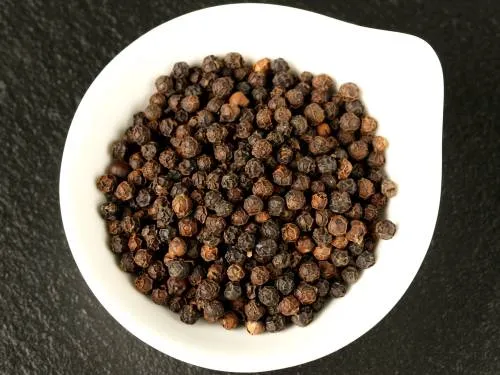
Black pepper is a hot, pungent spice that can be used whole or powdered. It is an important ingredient in many spice blends such as garam masala and curry powder. It is used extensively in South Indian dishes where it is used with mustard seeds and curry leaves to add taste and spice to the dish.
Whole peppercorns are used in pulaos and biryanis, in some sweet dishes to balance the flavor profile and in marinades and rubs. Freshly cracked pepper is used with eggs, mash, gravies, white sauce and other bland dishes to add spice and taste.
It is also used in dishes like Mushroom pepper fry, Pepper chicken and many Chinese dishes . Often black pepper may be used as a garnish or finishing spice on lentil dishes.
These are the basic spices used in Indian cooking, but there are a lot more. Here are some other spices that are often used in Indian kitchens:
Star Anise
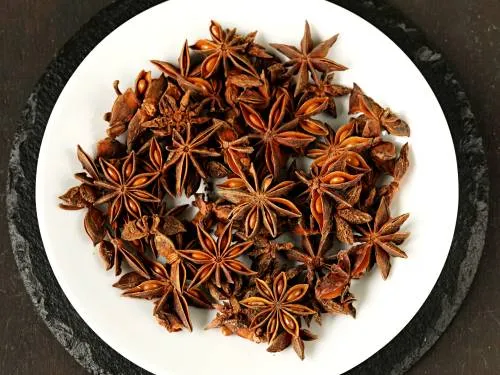
Star anise is a super flavorful spice which I personally don’t prefer to skip in my pulao, biryani, fried rice, kurma, fruit cake and a lot of meat based dishes. This is one spice that makes a huge difference when added to the above mentioned recipes. It has a strong liquorice taste, similar to that of fennel seeds.
It may be used whole or in a powdered form. Star anise is also used in Chinese five-spice powder. A lot of Chinese recipes call for this traditional spice. It can also be used in teas, marinades, soups, meat and vegetable stew.
Black Cardamoms
Black cardamoms are much bigger than green cardamoms and have a stronger aroma with a pungent smoky flavor. This is a spice not very commonly used and a lot of people also do not like the flavor. So if you don’t like pungent and smoky food, you may skip them in any recipe.
They are used more often in savory dishes and in garam masala. They are used in rice dishes like biryani, pulao and in many Indian gravies, either whole or powdered.
Nutmeg
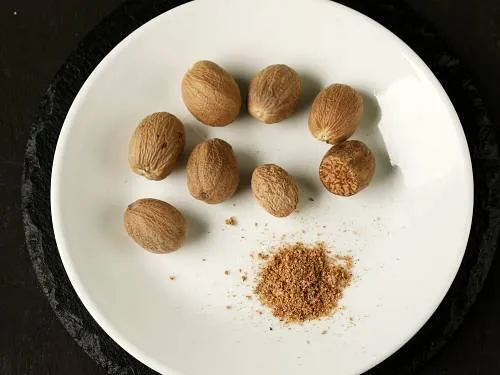
Nutmeg is more popularly used in South Indian dishes because of its warm, nutty, and sharp flavor. It may be used in tea, in some spice blends and sweet dishes.
Mace
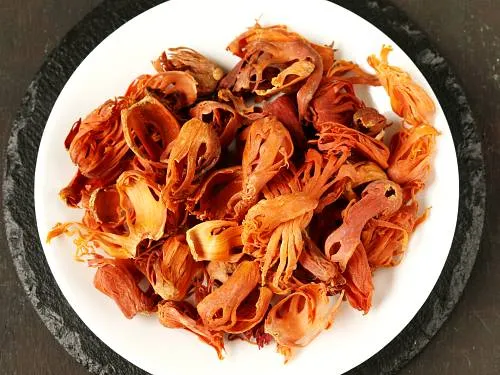
Mace is the outer covering of nutmeg, this lacy reddish covering has a milder and sweeter taste than nutmeg. It is typically used in small quantity in garam masala and in Mughlai dishes.
Caraway Seeds/ Black Cumin
Caraway seeds/ black cumin also known as shahjeera, is a smaller version of cumin seed, with a very different flavor profile. It is mildly sweet with a flavor somewhat reminiscent of fennel. It is used with rice, in curries, in soups and stews and blended spice mixes, mostly as a part of tempering.
Fennel Seeds
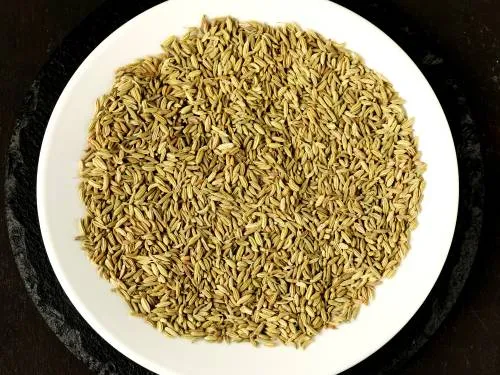
Fennel seeds are often used to flavor tea, for sweets and in fennel based syrups. They are often added to sweet dishes, some savory foods like certain lentils, pickles, pulao and kurma. They are often eaten plain or sweetened as a mouth freshener.
Asafoetida – Hing
Asafetida is a edible gum that is extracted from ferula plant. The resin is dried and processed to a block or powder before it reaches the shelves. It is used as a digestive aid and also adds flavor to your foods.
This pungent spice is usually sold as a powder which also contains flour a lot of times. If you are on a gluten-free diet, look for a gluten-free option & that comes in a block.
Hing is commonly added to hot oil while tempering lentils and some vegetables. It is important to note that it is a stimulant and should be limited. I use it only a few times to temper my Dal Tadka and similar dishes where it is essential.
Carom Seeds
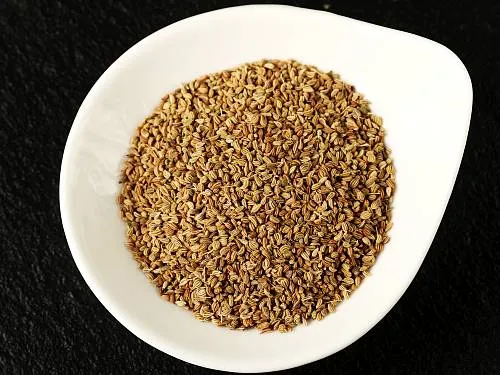
Carom seeds are another spice that aids digestion. It is one of the key spice used in Pakoras. Carom is added to many foods for its intense and sharp taste. It is used in parathas, some beans like chick peas or Kabuli channa, in tomato sauces and gravies, where it adds another dimension of flavor. It has an earthy and sharp taste, so used in minute quantities.
Ginger
Dry ginger – often sold as a powder, dry ginger is extremely spicy and hot. It helps in the digestive process and has an intense flavor of ginger. In a pinch, you can use ginger and garlic powder instead of the fresh chopped varieties to flavor dishes. But they both fresh and dried add different flavors.
Amchur – Mango Powder
Dry mango powder – known for its sourness and tang, it is made of unripe raw mangoes. It adds a sour element to many dhal dishes, in chaats, in certain vegetables and meats and also used as a final sprinkle on salads, pakoras and other snacks.
Saffron
Saffron is a expensive spice used sparingly. While it is popularly used in Indian sweets, it is also used in certain savory dishes like biryani and a syrup flavored with saffron is used with milk or a combination of milk and water as a drink. Saffron is often paired with pistachios (known as kesar-pista) in ice-creams and Kulfis.
Sichuan Pepper
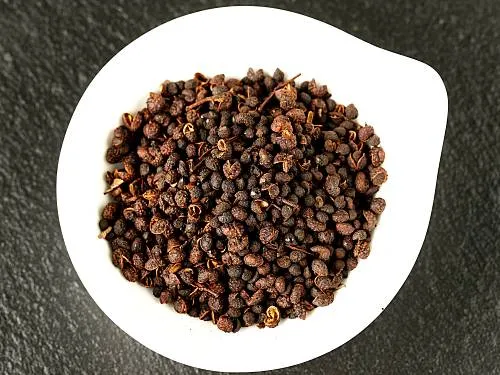
Sichuan pepper – this form of pepper is used in Chinese food, especially in the cuisine that is known as Indo-Chinese for its heat and pungency. It is found in what is known as Schezwan sauce or chutney in India.
If you are new to Indian food, do follow recipes with exact spice quantities to achieve the balance, taste and flavor that the food should have. While you may think that many dishes use common spices, it is the quantities and mixes that give the dish its characteristic taste.
Herbs that are used like spices
Though bay leaf and kasuri methi are herbs, consider them to be spices because they flavor your food.
Kasuri Methi
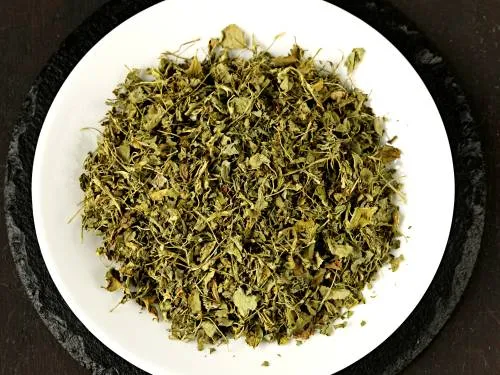
Kasuri methi is a herb that comes from the fenugreek plants which are known as methi. These leaves are slightly bitter in taste but impart a great unique aroma. Originally the methi that were grown in & around “Kasur”, a place in Pakistan were identified as the best flavorsome variety. Hence the name Kasuri Methi.
Later in the modern days, similar hybrid variety are grown which impart similar flavors and this is what is widely available across the world. So if you use regular dried fenugreek leaves you may not get the same flavors.
We use kasuri methi in North-Indian dishes like Paneer Butter Masala, Butter Chicken, Chicken Tikka Masala and lot of other dishes.
There is no substitute for this wonderful herb and methi seeds won’t work as a substitute.
Bay Leaf
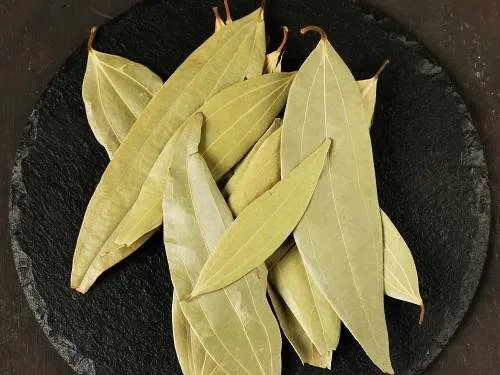
Bay leaf adds aroma and taste to many rice dishes, lentils, beans, stews and curries. It is often discarded before serving. These leaves are also added to spice blends like garam masala and meat masala.
These leaves are often used in Biryani, Pulao and many meat based dishes like Lamb curry. It is recommended not to use bay leaves that have been sitting for a prolonged period in the shelves because they impart a bitter taste.
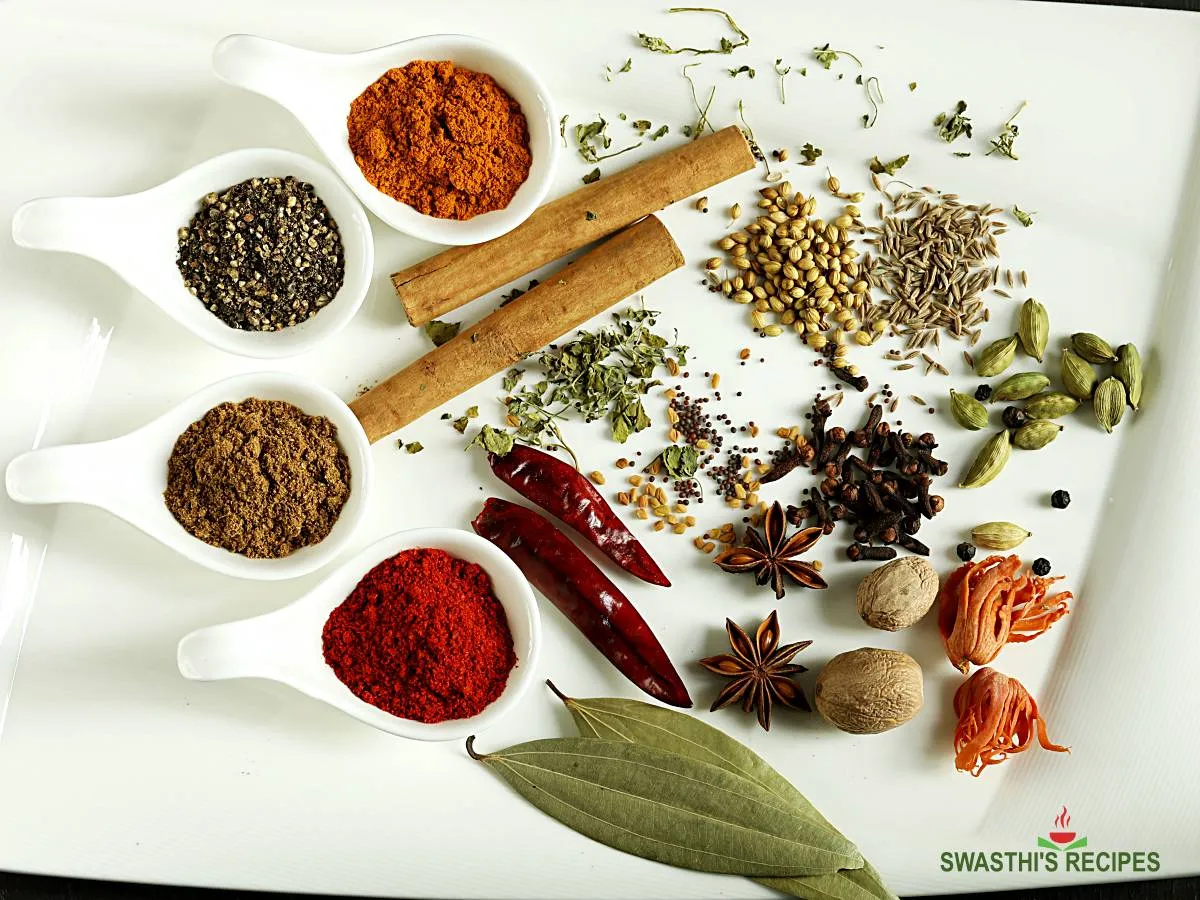
This post will be updated and enhanced further.
About Swasthi
I’m Swasthi Shreekanth, the recipe developer, food photographer & food writer behind Swasthi’s Recipes. My aim is to help you cook great Indian food with my time-tested recipes. After 2 decades of experience in practical Indian cooking I started this blog to help people cook better & more often at home. Whether you are a novice or an experienced cook I am sure Swasthi’s Recipes will assist you to enhance your cooking skills. More about me
Follow Swasthi’s Recipes

Comments
Can someone help me to choose condiments with quantity to make Tea Masala. I love Masala tea in very cold winter season of Calgary Canada. Reply me by email. Thanks
I have a recipe of Chai spice mix/ blend here. Hope you get to try
Great post!
Suggestion: Consider editing the bay leaf info so your readers understand it’s Indian Bay (Cinnamomum tamala), rather than the Sweet Bay (Laurus nobilis) commonly used in Mediterranean cooking.
Thanks Tom, I will edit that.
What about black stone flower? Do you not use it? It tastes amazing in biryani, pulav and some chicken curries
Thanks Aakanksha. Yes I do use them in meat dishes. Will update that soon
Caraway is not the same as shahi jeera.
Hi Jim,
Shahi jeera is known as caraway in India and Singapore (where I live). If it is not caraway, please share the English name for shahi jeera. I know it is different from black cumin (Kalijeera).
I agree with Jim. Caraway is not Shahi jeera. Shahi jeera if I’m correct is what is used as saunf – covered with sugar and a digestive. Fennel seeds that resemble jeera but are bigger and taste aniseed-y.
Caraway is used in cakes in the West and has a completely different flavour profile. In India, people often mistake carom seeds (ajwain) to be caraway. We used to get caraway when I was a kid many years ago. Not any more. If I ask for it, I receive either blank stares or carom seeds or fennel. Fennel is certainly not caraway. Carom comes closer in appearance. My mum used to scatter a few caraway seeds in her poori dough and it gave a nice crunch and burst of flavour once the fried poori was eaten.
I did an image search for Shahi Jeera and found photos of packaged spices that are labeled “Shahi Jeera (Black Cumin)”. I searched for Kalijeera and got results that included both Elwendia persica and (mostly) Nigella sativa labeled as “black cumin.” Could that be where the confusion lies?
Could there be some confusion with Nigella sativa? That is sometimes called Black Cumin.
Hello Swasthi,
I recently discover your web site, I’m enjoying very much reeding you and this help me a lot in bettering my Indian food recipes, please don’t laugh, because I’m doing always the same recipes and I want to enlarge my dishes by trying new ones, lately I try the Palak Paneer, it was pretty good, I like doing the masala, it is very good, in two days I’m going in town (Montreal) and will buy some spice that seems necessary. Thank you for helping me enjoying real Indian food. Celine
You missed out the important spices all-spice and pipli. Must use them to make recipes like nihari
Swasthi, pls add more pictures of the spices. Helps to identify them correctly. Last year I picked up a pack of long pepper mistaking them to be kapok buds. Thank you
This was very interesting and a great help in navigating the world of spices used in the indian kitchen. I look forward to reading about the masala dabba and the essential spices to have on hand.
ABSOLUTELY well guided Indian recipes from different regions
Thank you for obliging to make this list for us. Very helpful